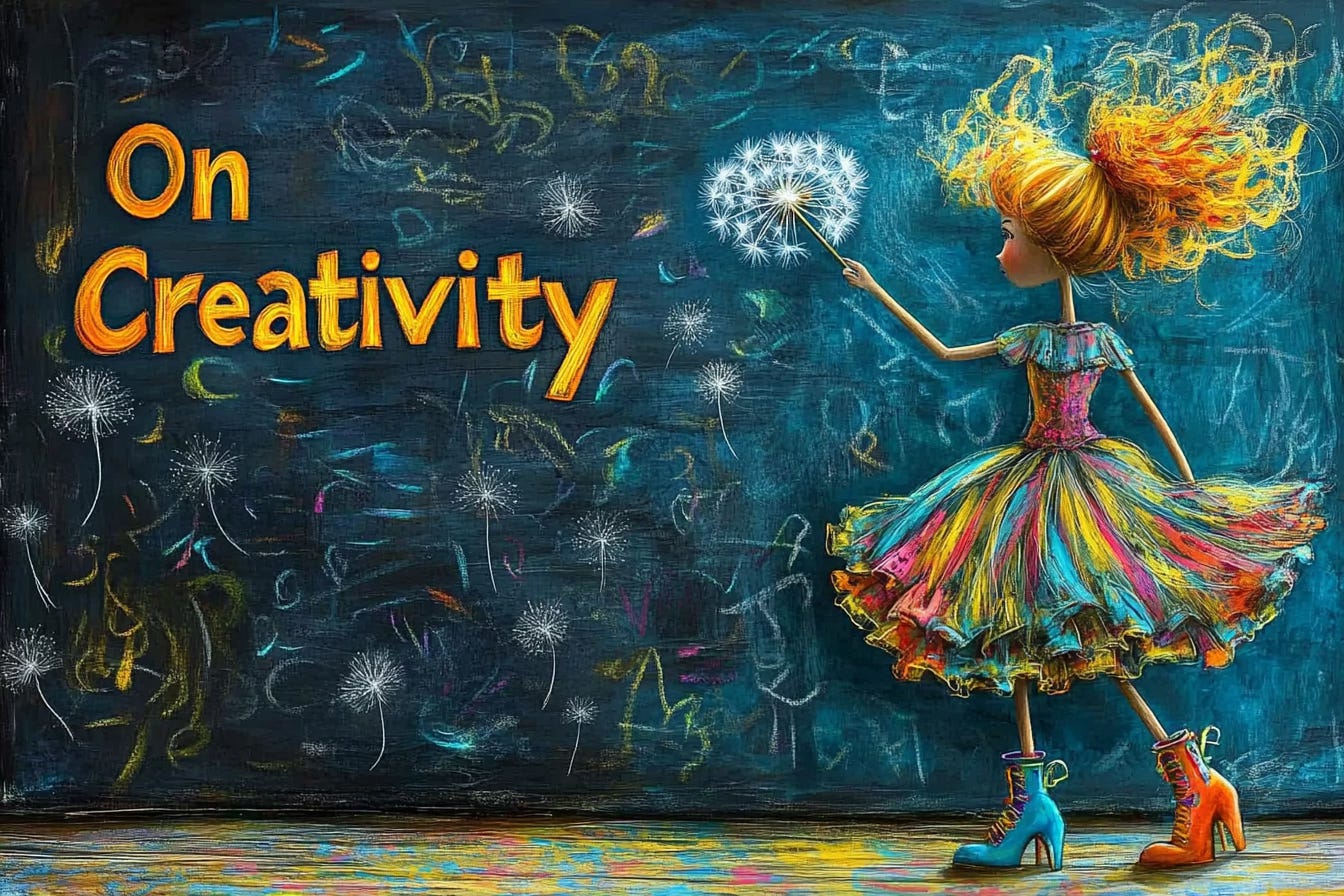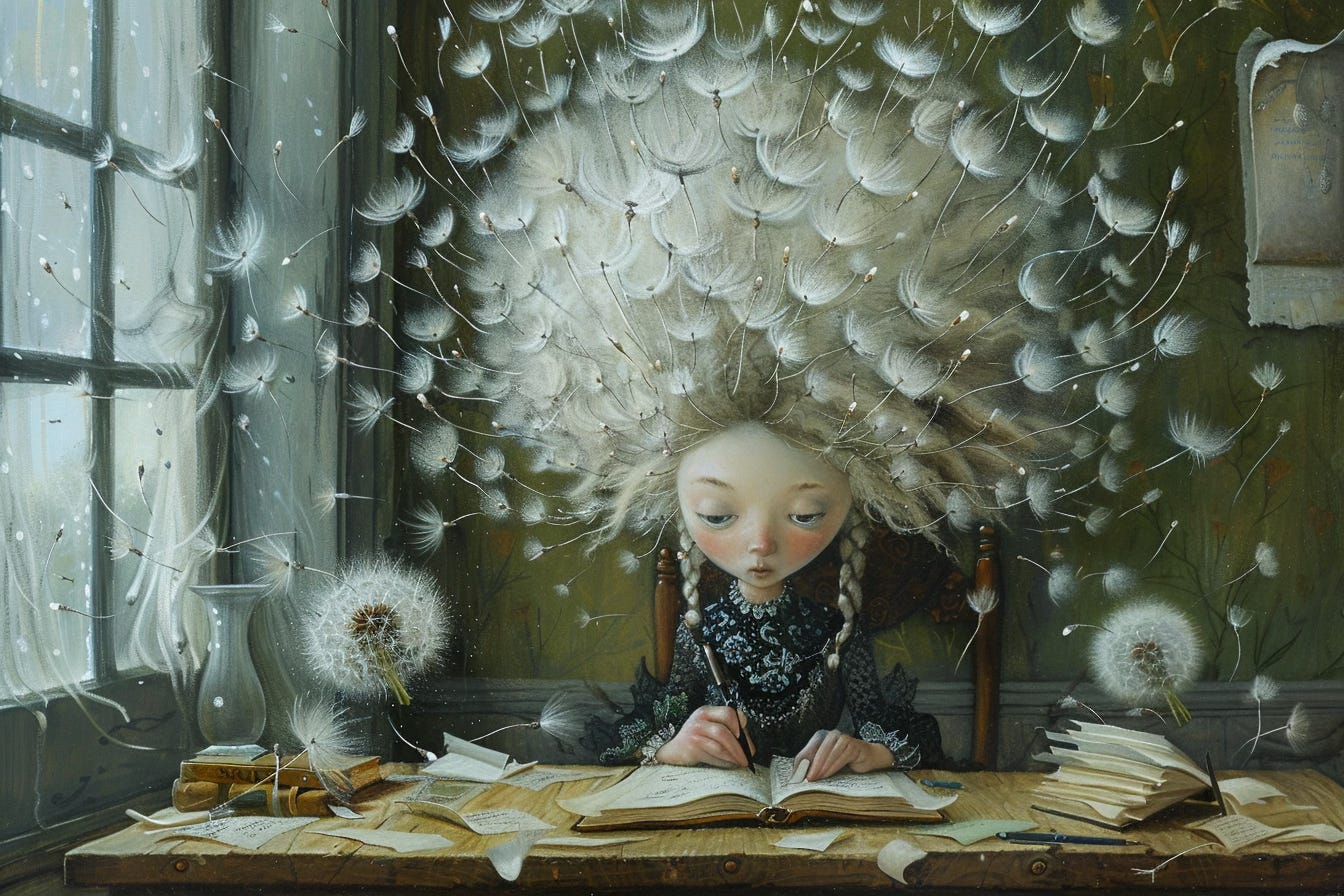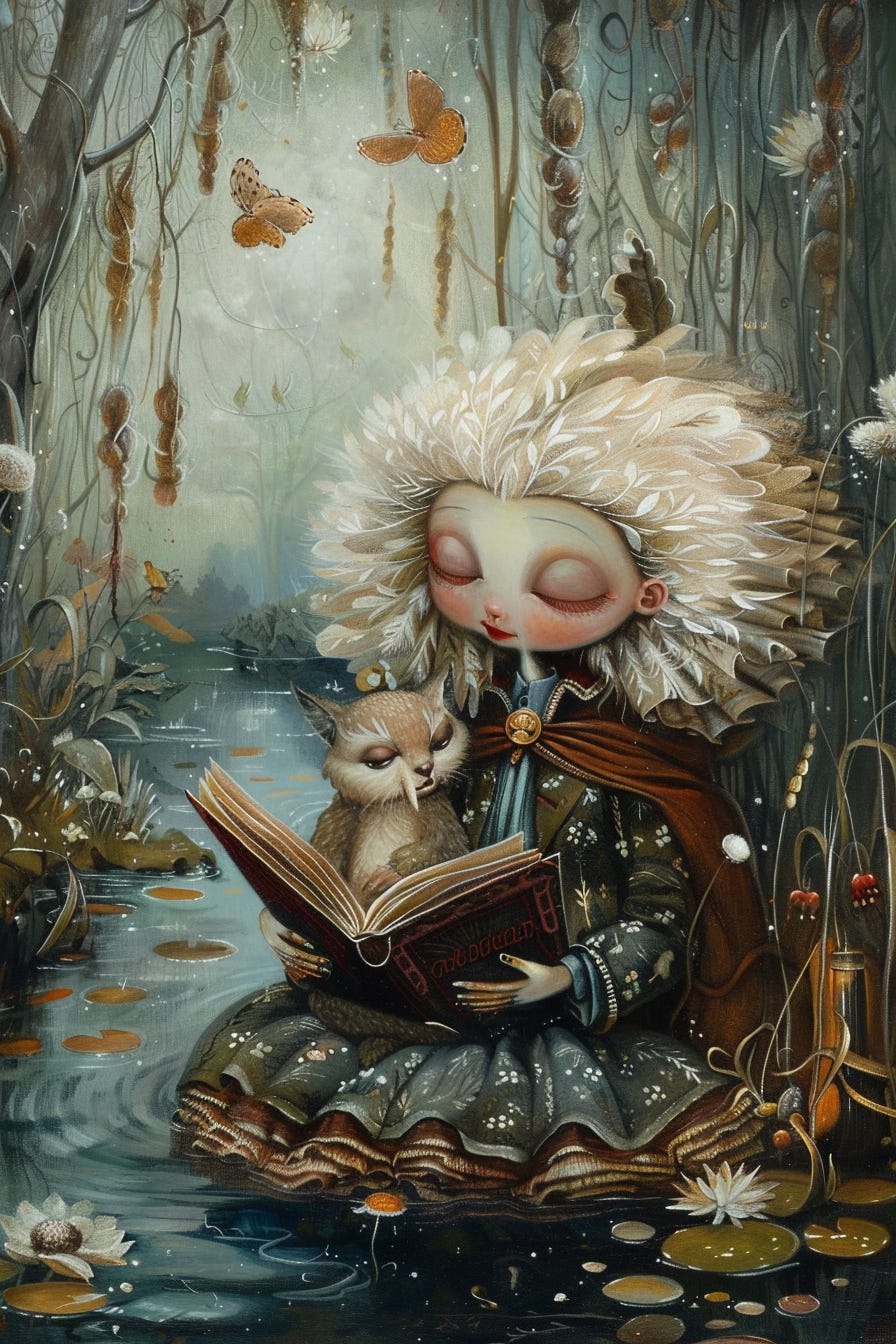On the Matters of Writing, Creativity, and Responses to Criticism, Part II
This is #2 in a series of three related posts on writing and related matters. The views presented herein represent only the perspective of me, Blowfuzzy von Sassy, and may be contrary to the views of other editors or writers at Rac Press. This diversity of thought is a wonderful thing, and in some small way illustrates how subjective the assessment of literature may be. Though many of our readers are fans who do not write creative literature, I hope they will find these posts as interesting as I hope that aspiring writers will find these posts informative and useful in their own writing practices.
People are naturally creative, and writing is one of the most delightful ways of expressing that creativity, in my view. You’re creative, too. Think of a time that you built an entire narrative in your head about a situation involving other people, only to find out that your narrative was the opposite of what actually happened: you’re already experienced at writing new stories in your head. Consider this Exhibit A in my argument that You Are Creative.
When I was a little kid, I lied a great deal about a great many things, to the consternation of my dear mother. (Sorry, Mom!) She would ask me why I lied about this or that thing, and I was often unable to give an account for my dishonesty. What didn’t help was that I got away with lying occasionally, like that time when I was five and Mom said we couldn’t go to the Overton Park Zoo until I brushed my teeth. I swiped a washrag across my perfect little pearly teeth, and Mom totally bought it. (Sorry again, Mom!) But the vast majority of my childish falsehoods were probably cringingly obvious to the poor adult on whom I inflicted them. Like the time I told Uncle Stan that I saw a kid at 2nd grade poke another kid’s eyeball out with a stick. I still remember Stan’s raised eyebrows, bemused, nodding and saying I must go to a really tough school. (Sorry, Stan.) I do recall being relieved that he didn’t press me on the particulars of that event, though I distinctly recall preparing to tell him about the deflated gooey clump glorping down the stick of the triumphant bully, who ran around the playground wielding eye-ball festooned stick like a drum major’s baton. Wasn’t that creative? Were you a child who lied, too? If so, I give you Exhibit B in my assertion that You Are Creative. [Side note, if you were the lying child and still lie on the regular, please stop lying. Make fiction your lying outlet and live with greater authenticity. We’ll all like you better for it, you’ll be happier, and you won’t have to work so hard to keep your story straight.]
Removing any pretense of dignity I may have previously feigned is a worthy price to pay to illustrate for you that creative thinking comes naturally to people, even well before one is able to write. If you have the urge to write, to make something that never existed before, TADA: I give you Exhibit C that proves You Are Creative.
Having established that you have the ability to generate an entirely new idea of Something That Didn’t Exist Before, what are you going to do with this? I recommend you begin to write forthwith and see where your ideas carry you.
“But Blowfuzzy, just because I had one stray wrong idea doesn’t make me creative. How am I supposed to turn a misunderstanding on my part into, yanno, a written story?”
I’m so glad you asked, dear reader. You will take that wrong idea and pull it like taffy in many directions. Take the misunderstanding and imagine all the non-existent moving parts that would have made your wrong idea plausible, and flesh that out. You can make a list of the features of that scenario. You can make a list of outcomes of the scenario you imagined. You might simply talk about the event and how people reacted, or you may craft a lovingly detailed account of the thing glorping down the stick, to the horror and amazement of the gape-mouthed onlookers. You may consider this writing a mere exercise to practice your baby-steps level skill, or you may begin writing and realize you have the germ of an idea that will be an entire novel, or series of novels. The novel of a thousand pages begins with a single page. Actually, it begins with a single word. Think about that for a minute.
Think of your writer self as a baby you are nurturing. What do you need to feed this baby? How do you sustain the baby writer? Give it fodder for content, but also give it exercise and expose it to the whole world waiting to be explored. Also, make sure to tidy up the messes that are a by-product of this baby. To this end, nurture your baby story by reading extensively, particularly if you need more information to write credibly on an extant thing or idea that already exists. Start a file and just write, as mentioned in the previous paragraph. Write on this subject until you are spent or set a kitchen timer for 30 minutes. There are many ways to do this, and by trying different approaches, you’ll find what works for you.
After a break from this writing jag, come back to your info dump and re-read your work, carefully and objectively noting the features of what you’ve written. Note the typos you tend to make. Note what types of constructions best show your original intent. Note the sentences that don’t quite work. Tidy up your work with multiple sweeps of proofreading1, one for structural issues, one for technical issues, one for flow when everything seems to be technically correct. Chances are, a narrative will start taking shape for you, and you’ll start nudging this bit and that bit, cutting and pasting things into better order as you go. Before you know it, you’ll have a mini story to show for your efforts. Will it be brilliant or even good? Maybe or maybe not. The point will be that you’ve taken that step in the direction toward sharing with the world that idea or story that you are uniquely capable of producing.
For a more involved form of exercise, choose a favorite album, preferably one you played on the tape deck as you saw how fast your first car would go. For me, it would be “Moving Pictures” by Rush, “2112” by Rush, or one of Boston’s first albums. The point is to pick an album that you could howl at the top of your lungs from beginning to end with no prompting. Take the first song and write a story about what’s happening in the story, or write about your favorite song, or the entire album – this is your thing and you get to define its borders. Okay, in all fairness, the first “Moving Pictures” track is “Tom Sawyer”, and we all know that story. However, can we expand our idea of Tom Sawyer by examining what these Canadian neighbors said about him?
A modern-day warrior
Mean, mean stride
Today’s Tom Sawyer
Mean, mean pride
Though his mind is not for rent
Don’t put him down as arrogant
His reserve, a quiet defense
Riding out the day’s events
The river
See what the writers did with the story we already knew? Tom Sawyer here is not merely a barefoot kid on a raft on the Mississippi in cutoff pants, but he’s a modern-day warrior, he is proud, he’s free of mind and spirit, and he’s got chill in abundance as he makes his way along the river of life. What can you do with this as a character?
No, his mind is not for rent
To any god or government
Always hopeful, yet discontent
He knows changes aren’t permanent
But change is
Such magnificent imagery! Wouldn’t the world be less rich if Peart, Lee, et al had not cobbled this character into a contemporary version 40-some years ago? Their version of the boy is admirable, relatable and inspiring. He is, for me, the embodiment of rugged individualism that I think defines the American spirit. It’s also a fun track to play when you see how fast your ’74 Camaro will really go. [Sorry again, Mom.] But the point remains, using this song as a point of departure for a new story, where does your mind take you? Would your Tom Sawyer be a stowaway on a spaceship, forging his own destiny in a new universe? Would your Tom be a rags to riches underdog that takes the corporate world by storm? Would your Tom Sawyer run up to the edge of extraordinary danger and excitement, and then chuck it all for a Grizzly Adams kind of life? I can see this character going in many directions, but I want to know where you see him go, because I already know where my mind leads.
This brings up another point on creative writing: if you have thoughts that you can’t build a world on something someone else has already created, take those thoughts, wad them into a ball, and fire them at the sun. Or write them on a paper and burn it. Twain’s Tom Sawyer was a composite of popular characters of Twain’s time, and he put his own spin on Tom with humor and wisdom. Shakespeare already pointed out that “there is nothing new under the sun,” so take this as your cue to slap your own spin on the stuff that’s already laying around all over the place. Indeed, the fact that nothing is new is an invitation to take the known thing and break the dickens out of it!
A word on putative originality, though: tread with care how and what you appropriate from existing intellectual property. Old things like Twain’s work are open source, their copyrights having expired many moons ago. Although I’d do something creative with the work whence I appropriate inspiration, I am careful to not even step up to the line of copyright infringement. I’m not suggesting you take all the songs of an album that is still very much IN copyright. I AM suggesting that you make a writing exercise entirely for personal use by creating worlds and stories based on what you find in a song or collection of songs. You’re taking pieces of a puzzle and making an entirely new picture. The sky is the limit. In fact, why would you want to re-tread the same ground another writer trod? Take the jumble of disparate features from various places, then blaze your own trail and paint an entirely new picture.
Once you feel you’re getting on your feet as a writer, look for opportunities to branch out and share your work with others. Joining a group with creative writing challenges can help to build new habits for regular composition practice. A good group will give you feedback on your work and will afford you the most skill-honing task of critiquing the work of peers. Some of the best workshopping I’ve done was when I worked in the Writing Center at my Uni as a peer tutor—it was astonishing how often I only recognized major errors I made commonly when I saw a similar faulty construction in the writing of a peer. Peer review and edit is one of the greater gifts you can give yourself as a writer, and it also helps to dispense with pesky insecurities about other people seeing your work. I know one writer group that is an embarrassment of riches, and we at Rac Press have seen many of their writers transform from the timid first steps to the full flower of authorship. We expect to see brilliant careers for those amazing authors who have shared their work with us.
One more word on self-consciousness with a peer group: it’s easier to take criticism when you’re working with people who share your goal of better writing. It’s much better to take that news from a peer and BEFORE you have published your work. If a peer says it, then the editor at a publishing house will be likely to notice the flaw, too, and certainly the reading public will catch the error. They will not be kind when they leave the reviews on Amazon. I know whereof I speak – one painful review I received said positive things about the characters and plot originality, but that the editing was terrible, so they gave my work one star and titled the review “Editing Needed.” To that point, when you pay an editor (as I did in the case of that book), make sure you check the editor’s work. I did not, so this really is on me. Lesson learned in more than one way in that case.
Remember to feed your inner writer baby, give it exercise, rest, recreation, and expose yourself to new things. Go to museums. Take a sandwich and a boiled egg to the park and watch how the other adults interact. What stories are happening with their lives? Take a thawed bag of peas and feed the ducks. What are the little duckie dramas you can imagine? When traveling, what are the back stories of all the people you encounter at the airport or at Bucky’s? How do their lives differ from your own, or how are they similar? Virginia Woolf’s “Kew Gardens” is a quick read but is an interesting character study wherein the narrative imagines the lives of the different people who happen to be at the park on that day. This kind of exercise can be quite broadening for your own idea of story/setting/character and also may spark the germ of future stories for you.
One more thing that may not be said often enough is that if you are writing for the kind of anthology story call we launch here at RacPress, read and re-read the call sheet carefully, and revisit the guidelines throughout your writing process to make sure you’re not drifting from the purpose of the story. If you’re writing for an anthology that is one of a series, then read the previous series entries and see what rings the bell for that editor or publisher. You don’t want to carbon copy what others have done, but if the editor tends to select stories for certain traits, such as humor, you may want to think about your approach with that regard. For example, for a moggies story, please don’t send me horror. A little spooky is okay, but, honestly, I like a lot of cozy in my anthologies. Your mileage may vary, as Mike has a broad stripe of Not Cozy in his anthologies. It’s a big tent with plenty of room for different tastes. The important thing is to recognize which audience you’re addressing, and play to the home stands.
There is no end to human creativity, and we humans love reading about ourselves. You have the opportunity to pull the narrative taffy for a bit, and see how far you can stretch it. When you’ve tugged that sugary, gooey treat into something even you can’t believe, my friend, you may be on to something.
Now get off social media and write that thing you’ve been planning to start!
Watch for an upcoming post from BvS on the transformative power of Proofreading.







Loved this, post. I need to stop hesitating on putting my writing out there.
Curious if you can share who the artist is for the images? I would love to see more of their work & maybe buy prints if they sell them. ☺️ Thanks!